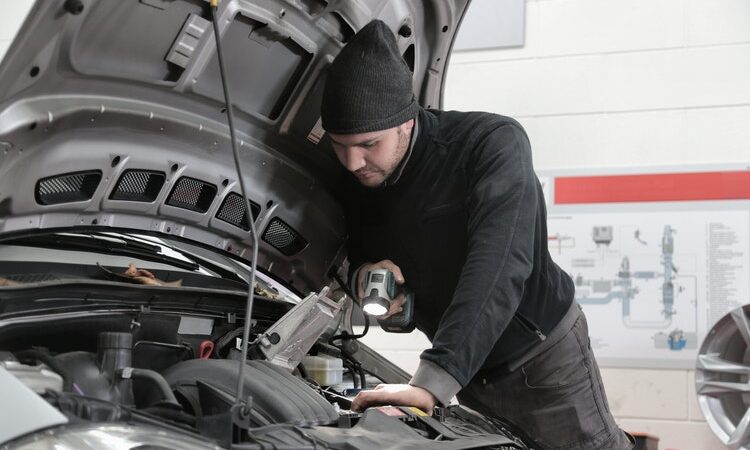10 Best Brake Pads {Plus} The 2020 Brake Pad Buyer’s Guide
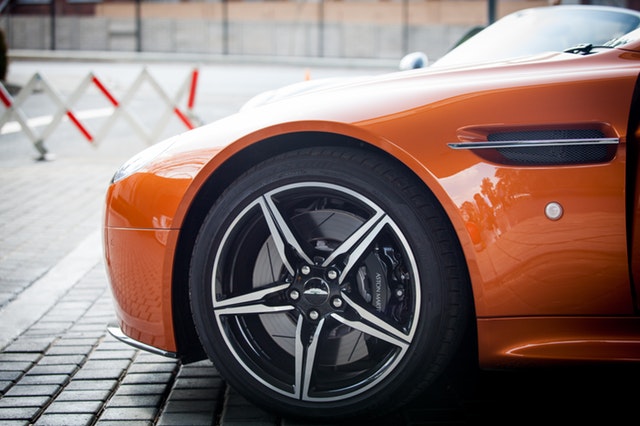
Top 10 Brake Pads of 2020 + The Ultimate Buying Guide
(last updated 5-29-2020)
Your brakes are one of the most important components of your vehicle. Brake pads are what allow your vehicle to slow and stop on command, so you’ll want to have the best brake pads you can for your style of driving. To keep your vehicle both functional and safe, it’s essential that you have good brake pads installed, and maintain them at all times. You can’t automatically go for the cheapest set of brake pads if you want to ensure the best performance.
The good news is that there are plenty of great car brake pads on the market that don’t cost a fortune to buy. Below, we’ll cover what we think are 10 of the best car brakes you can get in 2020.
We’ll also provide some tips for picking the best car and truck brake pads and cover some of the FAQs we get from readers.
So… What Are The Best Brake Pads of 2020?
| Brand | Dimensions in Inches | Durability Rating | Material | Pricing |
| Bosch BC914 QuietCast Premium | 8.5 x 5.4 x 3.3 | 7 | Ceramic | Check Price |
| ACDelco 17D1367CH Professional | 8.2 x 6.2 x 2.8 | 8 | Ceramic | Check Price |
| Power Stop K137 Front Z23 Evolution Brake Kit | 14.2 x 14.3 x 9. | 9 | Ceramic | Check Price |
| Akebono ACT537 ProACT Ultra-Premium | 6.5 x 3.7 x 3.2 | 7 | Ceramic | Check Price |
| Wagner ThermoQuiet QC1324 | 8.5 x 5.5 x 2.5 | 6 | Ceramic | Check Price |
1. Bosch BC914 QuietCast Premium Ceramic Disc Brake Pad Set
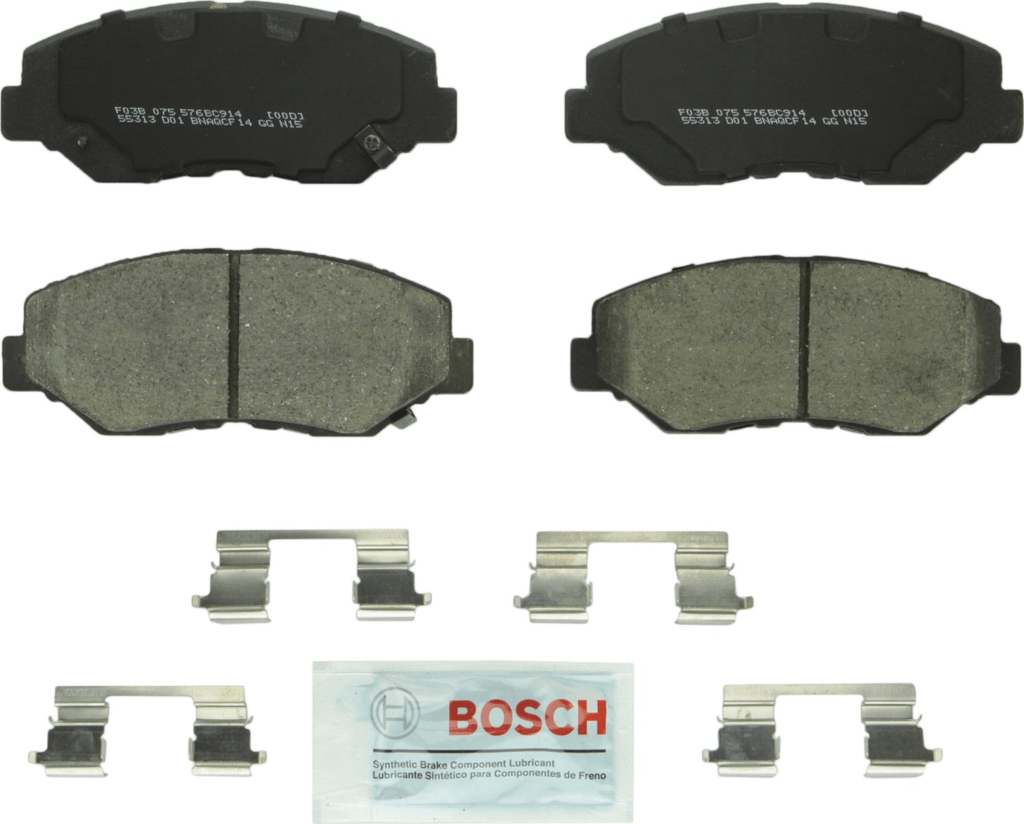
The Bosch BC914 Quietcasts take the prize for the best brake pads on the market this year. What stands out the most about the Quietcasts is how they balance exceptional stopping power with noise-dampening features. These pads are incredibly responsive, allowing you to slow and stop when you need to without ramming the brake. They’re also incredibly good at reducing noise levels, giving you a quieter, smoother drive.
These brake pads contain no copper, last for a long time, and the kit includes everything you need to install them out of the box.
Pros
- Excellent stopping power
- Noise-dampening design makes for one of the quietest rides we’ve ever had
- Incorporates unique design and chemical treatment to extend the life of your brake pads
- Great price
Cons
- Limited to mostly European and Asian models such as Honda and Nissan
- Not designed for heavy-duty use

2. ACDelco 17D1367CH Professional Ceramic Front Disc Brake Pad Set
ACDelco has been in the automotive industry since 1916. With the 17D1367CHs, they’ve leveraged every bit of expertise they’ve gleaned in over a century in operation. These ceramic pads offer excellent quality for stopping power, noise reduction, and durability. Since ACDelco are owned by GM, these pads will fit a wide range of vehicles.
These are also some of the best brake pads for towing on the market. Whether you need to haul a camper, trailer, or another vehicle, these pads deliver excellent performance.
Pros
- Some of the best stopping power on the market
- Fit most GM vehicles
- Includes 24-month, unlimited mile limited warranty
- Perfect for hauling trailers, campers, etc.
Cons
- Louder than other models
- A marked decrease in performance in colder temperatures

3. Power Stop K137 Front Z23 Evolution Brake Kit with Drilled/Slotted Rotors and Ceramic Brake Pad
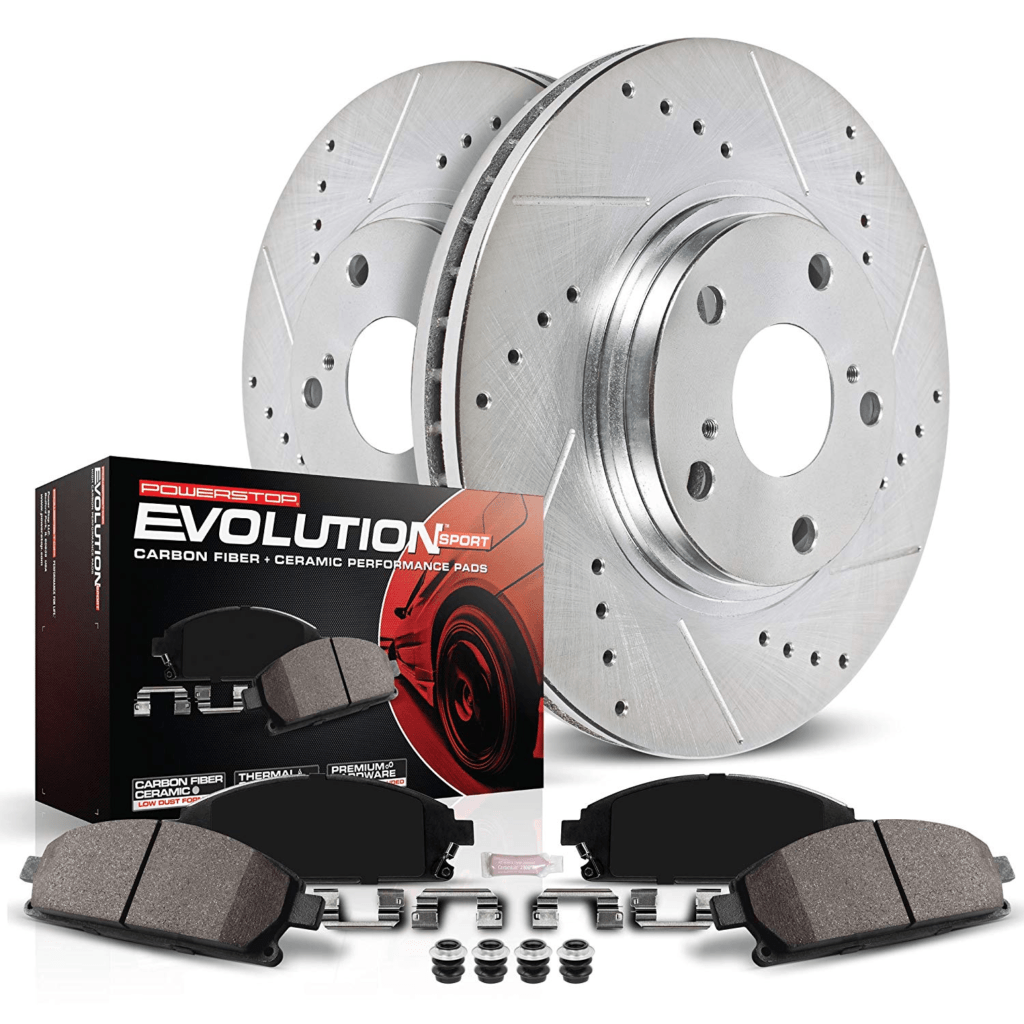
A relative newcomer to the automotive industry, Power Stop has nonetheless made a name for themselves with their excellent brake pads. The K137s are a testament to Power Stop’s commitment to providing the best aftermarket pads you can get. In addition to good stopping power, these pads reduce practically all noise. They’re also amazing at reducing the dust your vehicle kicks up when braking.
This brake kit is unique in that that rotors and pads are specifically designed to work together. This means that you’ll get maximum performance in one complete package.
Pros
- Superb braking power
- Pads and rotors precision drilled to match perfectly
- Some of the quietest pads we’ve found
Cons
- Much more expensive than other options
- Limited warranty includes very specific conditions to exchange
- Retaining pins and clips not as effective as those already on most vehicles

4. Akebono ACT537 ProACT Ultra-Premium Ceramic Brake Pad Set
Akebono sets a very high bar for what aftermarket brakes can do. They’re known to produce pads and rotors to the same specifications of OEM pads, and the ACT537s are no exception. These are by far some of the most durable pads on the market. With proper installation and break-in, you can expect to get way more mileage from these pads than most competitors. They’re also far superior to the standard pads installed on most models.
With superior stopping power and excellent durability, at a price that won’t break the bank, the ACT537s are simply some of the best pads you can get!
Pros
- Excellent stopping power that’s superior to most pre-installed pads
- Far more mileage before needing to change pads
- Great value at a low cost
Cons
- Primarily designed for Asian models, so they don’t fit a wide range of vehicles.
- The fit isn’t perfect on certain models (even those that are supported by Akebono)

5. Wagner ThermoQuiet QC1324 Ceramic Disc Pad Set With Installation Hardware, Front
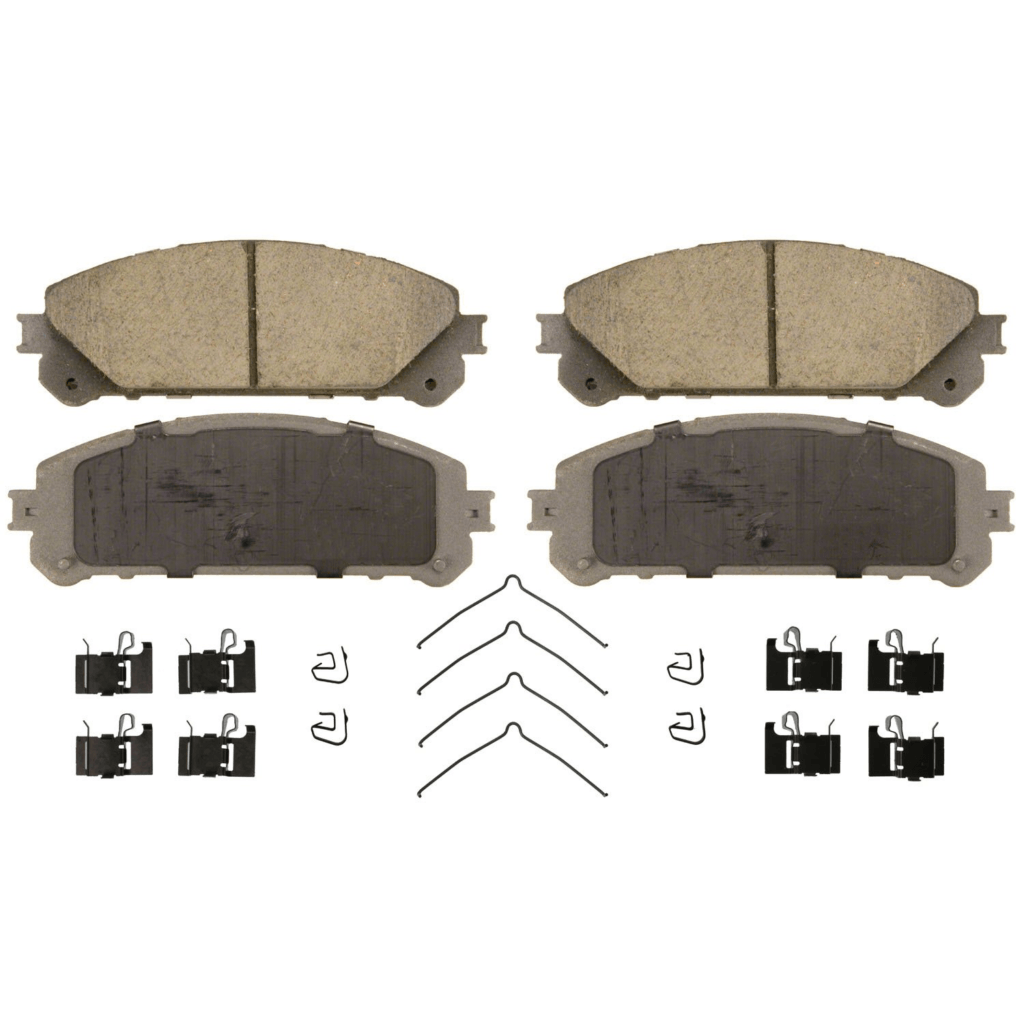
Wagner isn’t a household name in the automotive trade but don’t let that concern you. With the Thermoquiet QC1324s, Wagner has produced some of the best brake pads on the market. These pads are designed to substantially reduce the noise you experience while providing good stopping power. They also perform very well in colder temperatures compared to other brands.
Automotive newbies will also love the QC1324s because they’re incredibly easy to install.
Pros
- Good balance of stopping power and noise reduction
- Fit a wide range of vehicles
- Very affordable
- Easy to install
Cons
- Run smaller than most OEM pads, so the fit isn’t perfect
- Not as durable as other brands and will wear out faster
- Not copper free – may exceed regulations in California and Washington state

6. Toyota Genuine Parts 044650C020 Front Brake Pad Set
Toyota has worked hard to establish a reputation for producing quality vehicles. Nowhere is this more apparent than their brake pads, which are, hands down, some of the best you can get. When matched with a Toyota vehicle, these pads provide unbeatable braking power, reduce noise to practically nothing, and last for tens of thousands of miles.
While they may be pricier than most aftermarket pads you’ll find, the investment is well worth the performance and durability you get.
Pros
- The excellent performance that Toyota is known for
- Last much longer than competitor pads
- Fit perfectly on most Toyota models
Cons
- Limited to Toyota vehicles only
- More expensive than most aftermarket brands
- Not covered by the standard Toyota warranty (even if you have them installed at a certified Toyota dealer)

7. Hawk Performance HB302Y.700 LTS Brake Pad
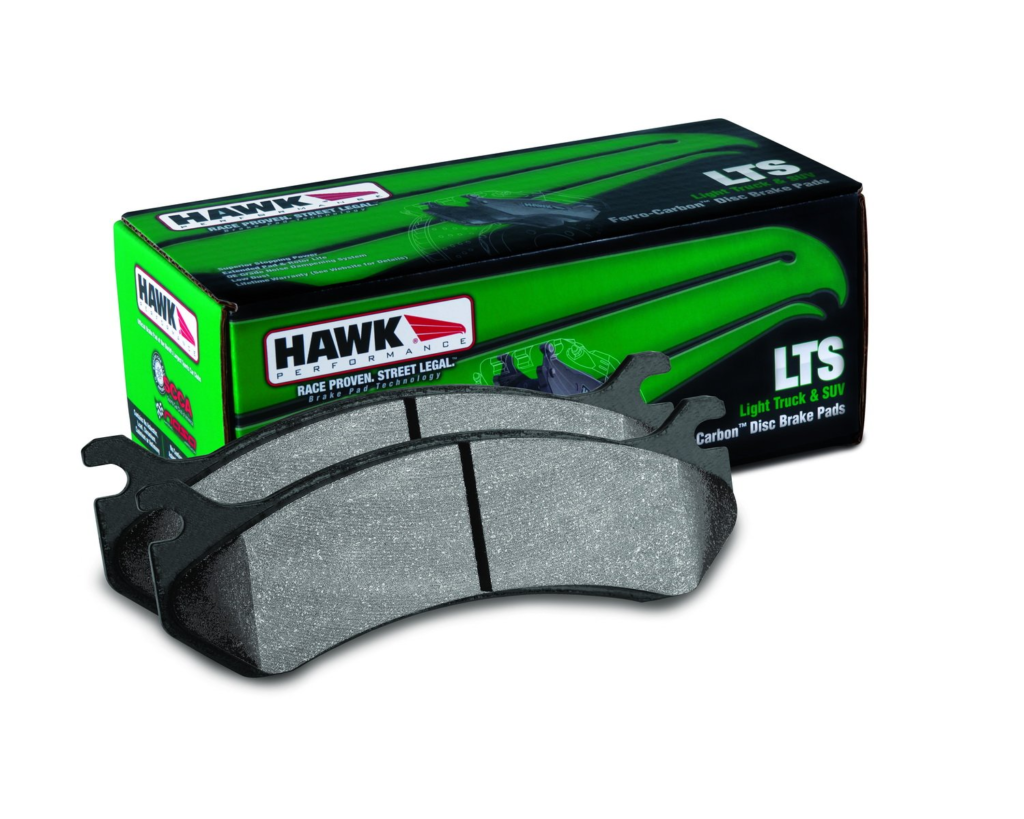
Hawk pitches itself as an aftermarket brand that improves on OEM pads in every way imaginable. By and large, they fulfill that promise, especially when it comes to their LTS pads. These pads were designed specifically for heavier trucks and SUVs. Compared to more general use brands, these brake pads provide excellent braking, dust-reduction, and noise-dampening capabilities on larger vehicles.
Hawk manufactures pads for nearly every type of vehicle. However, these heavy duty pads for larger vehicles are where they really shine.
Pros
- Custom-made for bigger vehicles
- Better stopping power than most OEM pads
- Maintain performance in inclement weather and while towing
Cons
- More expensive option than other pads
- Build up more dust than other brands
- Not a complete install kit – doesn’t include clips

8. KFE Ultra Quiet Advanced KFE914-104 Premium Ceramic Front Brake Pad Set
Another aftermarket brand, KFE bills themselves as a cheaper alternative to most brake pad manufacturers. While they definitely cost less than any other set on this list, that doesn’t mean the Ultra Quiet Advanced pads don’t work remarkably well. Aside from good noise reduction, these pads yield solid stopping power, good durability, and work better in cold temperatures than most competitors.
A final stand-out feature of the Ultra Quiets is that they require far less break-in time than most pads.
Pros
- Most affordable option available
- Superb cold weather performance
- Reduced break-in time
Cons
- Very specific to certain models – mostly Honda
- Braking tends to be rougher than with other pads
- Warranty only applies if installed by a certified brake specialist

9. Brembo P56048N Rear Disc Brake Pads
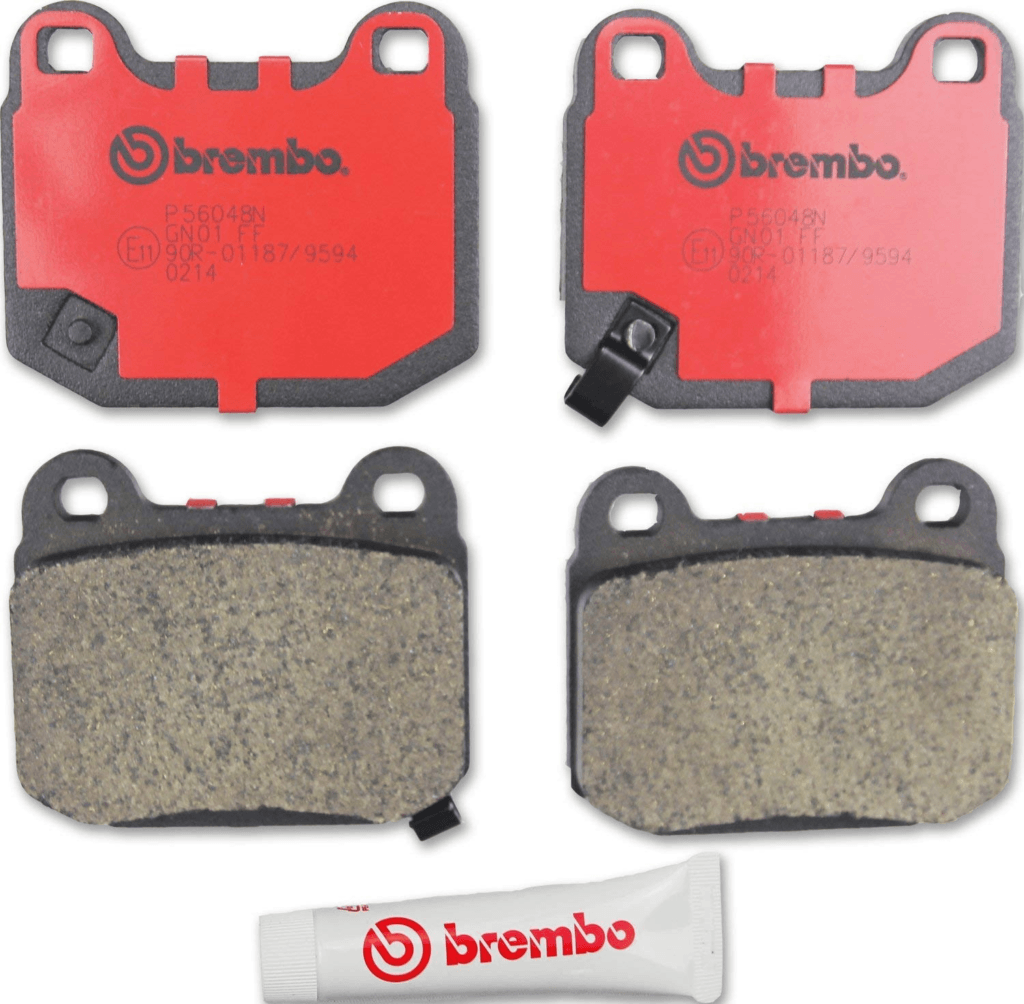
As an alternative to semi-metallic pads, you can’t beat these ceramics by Brembo. With good stopping power, great noise-reduction, and a great value at the price, Brembo has crafted a very fine set of brake pads. Since Brembo produces parts that cover a wide range of makes and models, you’re all but guaranteed to get the right fit with these exceptional pads.
These pads are also some of the ‘cleanest’ you can get. Even after extensive use, we noticed practically no brake dust at all.
Pros
- Best ceramic pads you can get
- Very affordable
- Fits a wide range of vehicles
Cons
- Wear out faster than competitors
- Tend to be a bit noisier on the initial bite
- Need to be paired with Brembo rotors for best results

10. Bosch BE923H Blue Disc Brake Pad Set
Another great offering from Bosch, these pads offer another great option for everyday drivers looking to get great performance from their pads at a great price. What sets these pads apart is their unique blend of both ceramic and semi-metallic materials. This results in a pad that dampens noise very well, yet still offers great braking capability. The pads are also incredibly durable and will last you through many miles of use.
Just like with other Bosch sets, the set includes everything you need to install the pads from start to finish
Pros
- Great price for great performance
- Ceramic/semi-metallic blend for great durability
- Reduce noise well
Cons
- Limited to mostly European and Asian makes and models
- Installation is harder than with other pads
- Leave far more brake dust than other pads

Brake Pad Buying Guide & FAQs
We think our Top 10 list of brake pads is a good starting point, but choosing a good set of car brake pads can be a tough decision. As you saw from some of the reviews above, various brake pads only fit certain models. In addition, you have to carefully consider the brake pad features that matter most to you.
To help you purchase the best car brake pads, we’ve created this comprehensive buying guide. It will help you gauge different disc brake products that you’ll find on the market, and give you some pointers for spotting the top disc pads.
The Most Important Features of a Great Brake Pad
While every brake pad manufacturer focuses on different aspects, you can boil the important aspects of a great set of pads down to four features: price, quality, applicability, and ease of installation.
Price
First and foremost, you need to understand that great brake pads don’t have to cost an arm and a leg. Unlike many car components, carrying a bigger price tag doesn’t necessarily mean better quality with brake pads.
Quality
Quality is a word that gets thrown around a lot. For brake pads, we define quality against a very specific set of parameters:
- Stopping Power – How smoothly the pads bring your car to a stop, and how responsive they are when you need to stop suddenly
- Durability – How many miles the brake pads can go before they need to be replaced. Additionally, how many miles the pads can last before you start seeing a decrease in performance.
- Noise Reduction – How well do the pads reduce noise (i.e. squeaking, squalling, grinding, etc.)
- Brake System Erosion – How well the pads reduce and dissipate heat, and reduce wear on the rotors
- Weather Resistance – How well the pads perform in extremely hot or cold-weather environments.
- Brake Dust Prevention – How much dust build-up and staining the pads cause over time
Applicability
We define applicability in brake pads as how many different makes and models they can be installed on. Most car manufacturers produce their own brake pads with their own benchmarks for quality. These are called original equipment manufacturer (OEM) brake pads. As a result, many aftermarket manufacturers design their brake pads to either match or outperform specific OEM pads. Others focus on designing pads that fit a wide range of vehicles.
The best brake pad brands balance a high benchmark of quality while allowing installation in a wide range of vehicles. However, be aware that it’s virtually impossible to design brake pads that will fit any make or model. Before you commit to a set of pads, you need to ensure they can be installed on your vehicle.
Ease of Installation
The final factor we recommend you consider when you select your brake pads is how easy they are to install. While they tend to be of higher quality, most OEM pads are not the easiest to install. This is because they are typically installed during the manufacturing process, and it’s assumed that replacements will be installed by a technician certified by that manufacturer.
Aftermarket pads vary in how easy they are to install. Those that try to cater to a wide range of makes and models tend to be easier to install. After all, the installation process can’t be too complicated or else they wouldn’t fit a large variety of vehicles. Aftermarkets that tend to stick with a just a few makes and models, like Brembo, can be quite a chore to install.
What Are The Types of Brake Pads and What Makes Them Different?
Aside from just OEM and aftermarket, there are many types of brake pads the market. Choosing the best brakes pads for your vehicle requires a combination of knowledge about the different types, as well as intimate knowledge of your vehicle. Below are some of the most common types you’ll encounter, along with some pros and cons for each type.
Semi-metallic
These types of brake pads usually combine some metallic substances, such as iron, copper, steel, or graphite, with other compounds. You can typically gauge the quality of semi-metallic pads by observing how fine the metal grains are. Higher quality semi-metal pads have very fine metal grains, while lower quality variants have larger, coarser grains.
Pros
- Cost less than fully metallic and ceramic counterparts
- Handle very well in cold weather
- Don’t wear on the rotors as badly as other types
- Perfect for racing vehicles
Cons
- Louder than some other types
- Don’t hold up as well on longer trips
- Wear out faster than other types
- Leave more brake dust
Fully Metallic
Unlike their semi-metallic counterparts, these brake pads are 100% metallic. This makes them far more durable in a wider range of conditions, but also means they carry some serious drawbacks too.
Pros
- Work well in a wide range of temperatures
- Respond incredibly well, with great stopping power
- Conduct heat well, reducing the risk of overheating on the rotors
- Incredibly durable, even over longer trips
Cons
- The loudest type of brake pads
- Tend to wear down the rotors faster
- Leave more brake dust than ceramic or organic
Ceramic
Ceramic brake pads are manufactured using a combination of copper fibers and other compounds. They were introduced in the 1980s as an alternative to the organic brake pads that had been prevalent until then. They work well in a wide variety of conditions, but carry some drawbacks as a result of that versatility.
Pros
- Work well in both hot and cold environments
- Soft materials produce less brake dust that doesn’t stick as much
- Dampen noise the best of any brake pad type
Cons
- Tend to be far more expensive than other types
- Wear down relatively quickly
- Don’t absorb or dissipate heat very well
Organic
Organic brake pads are the oldest type of pads, and still the most common, you can get. They’ve been around since the first mass-produced automobiles started showing up in the early 20th century. While they were originally produced using asbestos (since it absorbed heat incredibly well) the toxic nature of asbestos persuaded most manufacturers to swap to non-asbestos organic (NAO) compounds to produce their organic brake pads.
Pros
- Don’t produce a great deal of heat or wear on rotors
- Produce less brake dust than metallic and semi-metallic pads
- Very quiet when driving
- Usually very affordable
Cons
- Wear out more frequently
- Don’t handle extreme temperatures well
- Don’t respond as well for gradual or sudden stops
When Should Brake Pads Be Replaced?
Sooner or later, all brake pads will have to be replaced. The answer to the question of how many miles brake pads last depends on a number of factors. These factors include the type of brake pads being used, how often and how far you drive, the conditions you drive in, and what your driving habits are. For example, drivers who tend to “ride their brakes†will obviously need to replace their pads more often than someone who tends to decelerate before applying the brake.
In most cases, lower-quality brake pads will last around 30,000 miles, while more high-quality pads can last around 70,000 miles. If you’re a more cautious driver, your brake pads can last even longer.
How to Check Brake Pad Wear
In order to know when it’s time to change your brake pads, you need to look, listen, and feel for the signs your vehicle is sending. As your brake pads wear out, the signs will become more prevalent and easier to detect.
Audio Signs
Listen for a high-pitched screech that sounds like metal scraping metal. If you can hear it even when the windows are up, it’s time to change your pads. Be aware that you might not hear it over the sound of a loud A/C or car stereo system.
Visual Signs
For visual signs, there are two things you need to check for. First, check your actual tire and road wheel for signs of brake dust. If you’ve noticed a build-up of brake dust that suddenly gets cleaner on its own, that’s a bad sign. It means your pad has worn to the point that there isn’t enough material left to function properly.
Additionally, inspect the pad directly for signs of wear and tear. If you have less than a quarter inch of pad left or have significant chunks torn off, then it’s time for a new pad.
Feeling Signs
These are by far the most apparent signs you can detect. They’ll only get worse as the pads wear out more. First, you’ll start to notice that it takes you longer to completely brake, and you may need more stopping distance. You might also notice that you have to apply more pressure to break at all. Finally, there may be a slight vibration in the steering wheel and brake pedal that turns into a violent tremor over time.
How to Choose the Correct Brake Pads
When it comes time to choose the brake pads that will work best for your vehicle, we recommend that you follow these steps to get the best result:
- Determine the environment you live in. Living in extremely hot or cold environments means you’ll need to get very specific types of pads. Otherwise, you’ll be replacing them constantly. Also, know if your environment has a lot of hills or other rugged types of terrain you drive on frequently.
- Analyze your own driving habits. Do you take a lot of long road trips or mostly just commute to work? Do you tend to drive fast and brake frequently or slowly decelerate, tapping your break at the last possible minute?
- Once you have a good understanding of the above, decide between metallic, semi-metallic, ceramic, or organic pads.
- Check the brake pad manufacturer’s data to ensure that the pads will match the make, model, and year of your vehicle.
This isn’t scientific, but we’ve devised three different driving personas to help you gauge which type of brake pads are probably your best bet:
- Extreme Road Warrior – You live in an extremely hot or cold environment, drive fast and have to navigate a lot of hills. You may even race cars as a hobby. You probably need to stick with metallic or semi-metallic brake pads
- Travelling Businessman – You spend a lot of time on the road but only drive fast when you’re running late to an appointment. Fortunately, you don’t have to endure much rough terrain or extreme temperatures. You most likely need either semi-metallic or ceramic brake pads.
- 9-to-5 Commuter – Aside from the occasional road trip, the only times you use your car are to get to work or go shopping for groceries. You don’t drive very fast, but you use your brakes frequently because you live in an urban area, where traffic is heavy. You should opt for either a ceramic or organic brake pad.
How to Change the Brake Pads
Changing your brake pads may sound intimidating, but trust us: you can handle it just fine. By buying and changing your own brake pads, you stand to save a lot of money and heartache. Not only will you avoid labor costs from having a mechanic do the job, but you can also save on the markup most dealerships and body shops give themselves to order your pads.
Important Note – Before you start to change your brake pads, check your vehicle’s warranty. If it specifies that the warranty on either the vehicle or the pads will be void if you install it yourself, you may want to consider taking your vehicle to a certified technician.
The Tools You Need to Change Your Brake Pads
Just like any other auto-maintenance job, changing the brake pads requires a few tools. Before you get started, make sure you have the following assembled:
- Your owner’s manual (aside from general how-to’s, it may have some specific data regarding the brake pads)
- Floor Jack
- Jack stands
- New pads (and rotors if necessary)
- Brake grease
- Socket wrench
- Tire iron
Steps to Change Your Brake Pads
Once you have your tools assembled, you can begin to change your brake pads by following these steps:
- Using your tire iron, loosen the lug nuts on the wheels with the pads you’ll be replacing. This will prevent your wheels from spinning once you elevate your car.
- Using your floor jack, elevate your vehicle the ground where you can work comfortably. Always ensure your vehicle is level before you proceed. Failure to do so can result in severe injury or even death.
- Place the jack stands under the weight points as specified by your owner’s manual. Lower your vehicle until it rests comfortably on the stands.
- Finish remove the wheel lugs.
- Remove the caliper assembly using your socket wrench. Here’s a video that shows you exactly how to do this.
- Remove the old brake pads.
- Apply brake grease to the back of the new pads.
- Install your new pads.
- Reinstall the caliper assembly.
- Reinstall your tires and lower your vehicle.
How Long Does It Take to Change Brake Pads and Rotors?
This depends on three things – what type of vehicle you have, the ease of installation on your new pads, and your own skill. Experienced technicians can change a complete set of pads in as little as 15 minutes. For a first time DIYer, give yourself about an hour to work through the process.
How Much Does it Cost to Replace Brake Pads?
If you’re doing the job completely on your own (and already have your own tools), the only real cost you’ll have is the new brake pads. While there are definitely some high-end pads geared for increased performance, you can get great brake pads for anywhere from $25 to $75.
If you choose to have a dealer or body shop order and install your brake pads, it will cost you about $250. You can also land somewhere in the middle by purchasing your own preferred pads, then having someone else install them.
Don’t Forget Your Rotors
When we’re talking about brake pads, it’s nearly impossible to explore the subject without also addressing rotors. Your rotors play just as important a role in your vehicle’s brake system as your brake pads. Your pads have to compress against something to stop your wheels from turning and that’s where your rotors come into play.
While more durable than pads, rotors will still wear out over time. Typically, you can expect to get anywhere from 15,000 up to 70,000 miles from OEM rotors. Depending on how much bite your brake pads have, your rotors could wear out even sooner. Additionally, if your pads don’t disperse heat well, your rotors can start to overheat. This can both warp them and wear them down much faster.
Do Your Rotors Need to be “Turned?â€
“Turning†your rotors refers to the process of resurfacing them. As rotors begin to warp and stretch, they lose their rigidity and circular shape. This can cause severe vibration in your braking system and make it more difficult to apply the brakes quickly. Turning the rotors basically reverses the aging process to a certain extent, allowing you to get a few more miles off your current set.
Before you decide whether to turn or replace, here’s a few things to consider:
- New rotors are expensive. Turning your rotors can save you money. However, service centers typically only resurface to the original specifications. If this doesn’t eliminate your issues, you’ll need to replace your rotors anyway.
- Even if your rotors are less than 10 years old, you might benefit from upgrading. Advancements in technology have produced rotors that are lighter, stronger, and more durable.
- No matter how good a resurfacing job is, resurfaced rotors will not be as safe as brand new ones. After turning, your rotors will be thinner, more susceptible to heat, and warp more easily. To ensure maximum safety, buying new rotors is your best option.
FAQ
1. How Do Brake Pads Work?
Brake pads work by compressing against your rotors, which causes your wheels to stop spinning. When you press the brake pedal, what you’re really doing is pressing a lever against a piston. As this piston moves through the cylinder, it’s releasing brake fluid. The brake fluid then presses against a second piston, which directs your brake pads to compress against the rotor. The degree that your brake pads compress is based on the amount of brake fluid being pushed against this second piston.
2. How Many Sets of Brake Pads are On a Car?
You need two sets of brake pads if you’re replacing both the front and back wheel pads. A ‘set’ consists of four pads, two per wheel.
3. How Many Miles do Brake Pads Last?
Typically between 30,000 and 70,000 miles. Factors that can influence total mileage are the quality of the pads, temperature, terrain, and your driving habits.
4. How do I Deglaze Brake Pads?
Glazing results when your pads have heated up to such a degree that they become very smooth. When this happens, they no longer provide enough traction to stop the momentum of your wheel. To deglaze your brake pads and rotors, simply sand them with fine grit sandpaper, then rinse with brake cleaner.
5. Why do Ceramic Brake Pads Squeal?
The squealing is a result of the back of your pads vibrating against the caliper at a fast rate. The bad news is that this squealing can get annoying. The good news is that it’s very common, and doesn’t indicate that there’s a problem with your brake pads. To stop the squealing, simply remove the pads, apply more brake grease, then reinstall.
6. What Causes Brake Pads to Wear Unevenly?
Typically, one of two causes will be the culprit.
The first is an uneven variation in the thickness of your disc rotors. This is called disc thickness variation (DTV). As the pads come in contact with the rotor, rotors with uneven thickness will chew away at the pads at an accelerated rate. The problem then is that you’ll not only have to replace your pads – you’ll have to either turn or replace your rotors as well.
The second possible reason is an issue with your brake calipers. Specifically, the guide pins used to install the brake pad and rotor within the caliper will sometimes latch on to the pad. When this happens, it can cause your pad to drag against the rotor, even if you’re not engaging the brake. If this happens, apply some brake grease to your pins or replace them.
7. What are the Best Brake Pads for Cars?
As we’ve covered in the above, this will depend on the type of vehicle you drive, the environment you live in, and your driving habits. My personal recommendation from our Top 10 list is the ACDelco 17D1367CH Professional Ceramics. They fit a wide range of GM vehicles, are easy to install and hold up well even if you drive extensively.
8. What are the Best Brake Pads for Trucks?
Same as above. My personal pick (and the pads I use on my 2012 Chevy Silverado) are the Hawk Performance HB302Y.700 LTS. They’ve got the stopping power and noise dampening capability I need for my truck. Plus, I’ve had them on for a good 15,000 miles now, and they barely show any signs of wear.
9. What are the Best Brake Pads for Towing?
My recommendation has to be the ACDelco 17D1367CH Professional Ceramics. They work just as well for towing as they do for cars.
10. Do I Need a Professional to Replace my Worn Out Brake Pads or Rotors?
The short answer is no you don’t. The long answer is that if you’re not confident or comfortable choosing your own pads and installing them, then yes, you need a professional. Additionally, if your vehicle is still under warranty, it may require that you have them installed by a professional. Read above to learn more about selecting and installing your own brake pads.
11. Why Do Some Brake Pads Produce So Much More Brake Dust Than Others?
Because different materials have different consistencies and “stickiness.†For example, as ceramics grind down, they produce more of a fine mist, almost like sawdust or sand. Ceramics tend to leave very little brake dust because the material is so fine, even when it’s hot.
Metallics and semi-metallics, by contrast, have a very thick consistency. As they heat up and grind down, the metal melts and becomes sticky, like tar. These two brake pad types tend to leave more brake dust than any other.
12. Do I Have to Make any Alterations to My Car to Install New Brake Pads?
It depends on the pads you select. Some pads are designed to work with the existing guide pins that you already have in your caliper assembly. Others have their own customs pins. The first thing you need to determine is whether or not the pads you’re interested in are compatible with your vehicle. If they are, they shouldn’t require any alterations.
13. If I Change my Brake Pads, Do I Have to Swap Out My Rotors Also?
Not necessarily. Most brake pads are designed to work with virtually any rotor system. The main issue you might encounter is sizing. Brake pads come in various sizes. If they’re not aligned and making good contact with the rotors when you apply the brake, they can’t do their job.
When you buy a new vehicle, the rotors and brake pads have been sized to match each other. As you swap both out, that balance can be thrown off. You need to check this before you leave your new pads installed. So long as the size and alignment are a close match, you don’t have to swap out your rotors.
However, anytime you swap your brake pads, you need to check the rotors as well. If they’re looking worn or warped, then you either need to replace or resurface them.
14. How Often Should I Check My Brake Pads and Rotors?
Generally, you should check your entire braking system every six months, or about every 5,000 miles. If you take your vehicle to a service center for your service job, ensure you have them check the brakes pads and rotors as well (most do by default).
If you’re having trouble stopping, have excessive noise whenever you brake or experience a lot of vibration when you brake, you need to check your pads and rotors immediately.
15. Do I Have to Change Out My Brake Fluid if My Pads and Rotors are in Good Shape?
Your brake fluid is a component of the braking system just like your pads and rotors but it’s completely separate from them. You can have completely new rotors and pads but still, have bad brake fluid, and vice versa. Even if your pads and rotors are in great shape, you may still need to swap out your brake fluid.
If you find that you have to push your brake pedal nearly to the floor or pump your brakes to stop, you may need to swap your fluid. Additionally, if the brake light is illuminated on your console, it’s probably time for a fluid change.
16. Organic Vs Ceramic Brake Pads – Which Are Better?
There’s still debate concerning this, but we’ll do our best to present the argument objectively. So again, in regard to ceramic or organic brake pads, which is better?
Organic Brake Pads
Organic brake pads are made of natural materials. Rubber, glass and even Kevlar have been used in them. The most noticeable – and most likeable – thing is that they engage the rotor quietly, due to their soft makeup.
Almost equally noticeable and likable is their price. Manufacturers can obtain the materials for this type of brake pad easily and affordably, all of which are passed on to car owners.
On the downside, they wear much easier than other pads, and dust buildup is significantly greater than other pads as well.
What kind of driver would benefit more from this type of pad? Obviously, these pads were not built for heavy duty conditions. So if you drive a smaller, lighter vehicle, and you’re not an aggressive driver, then you may like organic pads.
However, if you own a larger vehicle more prone to heavy duty operation, then ceramic brake pads could be the way to go. Let’s take a look at those now.
Ceramic Brake Pads Vs Organic Brakes
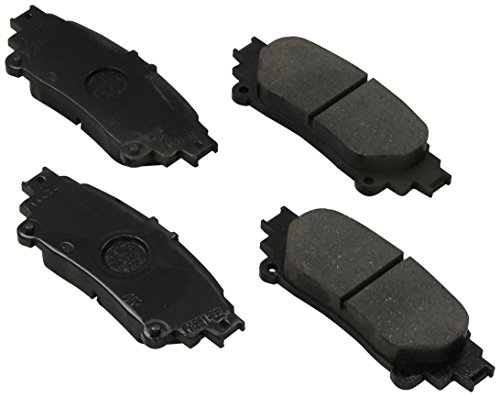
Right off the bat, ceramic brake pads are built to last much longer than organic. They take longer to wear down, due to their less-than-abrasive nature. While they still produce dust, it’s much less, and as a bonus, you won’t find it all over your wheels, as it doesn’t stick to them.
Another factor that ceramic brake pads respond well to is variations in temperature. When brake pads are pushed against the rotors, the intense friction can produce extreme heat. So this can help protect your braking system, including the calipers, which can seize after being overexposed to this very heat.
While ceramic brake pads are designed to take the rigors better than organic, they have proved to be reliable for most vehicles.
With performance like that, you’d expect them to be more costly than organic – and they are. You can understand why. Back on the plus side, they are still less expensive than metallic brake pads, which you’d find on sport utility vehicles or trucks. In fact, ceramic brake pads are not recommended for these vehicles.
So let’s recap. If you have a light to mid size vehicle, and you want to have reliable brake pads, ceramic is the way to go. If you’re on a budget and you are not rough on your vehicle, organic can get you by pretty decent for a while.
So aside from a few personal preferences, ceramic brake pads seem to be the better option over organic. They are a bit more of an investment, but will last far longer than organic brake pads.
If you’re considering either one of these types of brake pads, we hope this article proved helpful to you.
Bryce Newell is an automotive enthusiast who loves to write about the latest news, products, and DIY projects. While Bryce is an amateur in the field, he is passionate about cars and has been since he spent weekends in the garage helping his dad rebuild a 68 Dodge Charger as a kid.






